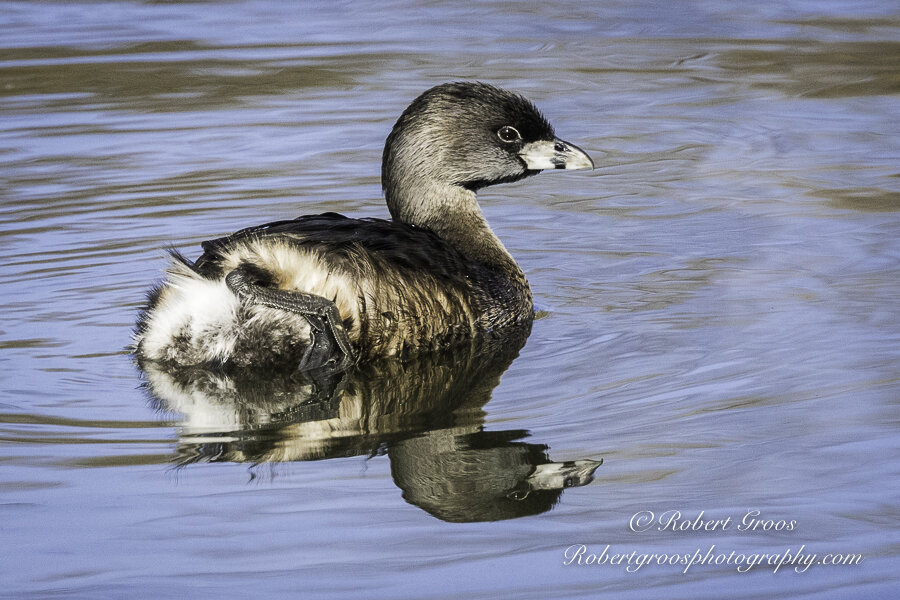Pied-billed Grebe
Last Fall, I fell in love while walking around Blue Heron Lake not far from my home in the oak woodlands south of Yosemite National Park..
The object of my infatuation was the cutest little aquatic bird with just a stump of a tail: a Pied-billed Grebe. I came across one floating in the still water on a quiet, forested part of the lake. As the grebe paddled in place, it sent waves of concentric circles across the water. Beautiful colors of lakeside fall foliage reflected all around. I was hooked.
Fall color on waves of concentric circles surround swimming pied-billed grebe..
Off and on I spotted five Pied-billed Grebes. A couple of my birds had a black band on their normally white bills, (hence, “pied-billed,” i.e. bi-color, as in the black and white color of the magpie), signaling they were breeding adults.
Black band on bill signals a breeding adult pied-billed grebe..
I was excited by the prospect of eventually photographing a pair nesting on the floating aquatic plants growing in the protected area where the grebes gathered when not fishing. Visions of fuzzy little chicks riding on their parent’s backs formed in my mind’s eye. Alas, it was not to be. But, wait, I am getting ahead of myself.
Unlike birds that forage on both water and land, the grebe is optimized for life on the water. The Latin genus for the Grebe family of birds means, descriptively, “feet at the buttocks.” And that is where the feet are. The legs are positioned so far back on its anatomy that, with the agility of a yoga master, a Pied-billed Grebe can flop one lobbed foot over to the opposite side of its back. Humorously, an early English nickname for grebes is “Arsefoot.
Pied-billed grebes are distinguished by lobbed feet on the buttocks.
Pied-billed Grebes also have the ability to disappear, quietly and without a ripple, right before your very eyes. Instead of diving or flying away when disturbed, they can trap water in their feathers and simply submerge like a submarine.
Fish, frogs, and crustaceans make up the bulk of their diet. They even eat their own feathers, and likewise feed those feathers to their young. This action apparently forms a lining in their stomach that prevents the bones and cartilage of their prey from slipping down into the intestine. Then, from time to time, the birds regurgitate those parts.
Pied-billed Grebe eating a feather..
I dedicated a lot of time observing the daily routines of my grebes. They began their day fishing. Swimming underwater for their morning meal, they would invariably come up with a catch in a relatively few dives. Early to mid-morning was meal time; the rest of the day was time for grooming and chilling out in the more secluded area where I first discovered them.
Floating bookends.
By late January, circumstances had evolved: it seemed that the grebes took longer to catch a fish. Come February, the fish they caught looked bigger; they were harder to swallow. One grebe even let a fish go after repeated efforts to swallow it failed. They foraged in greater expanses of the lake.
Grebe with a small fish.
Pied-billed Grebe catching a large fish.
Pied-billed Grebe with an even larger fish.
Pied-billed Grebe attempts to swallow a large fish.
Behavior towards one another also changed. When smaller fish were plentiful, there was no competition for food. Everyone was friendly and went about their business. As it took longer to find a meal, however, a grebe with a fish would turn and quickly paddle away from any bird that came near.
Efficient paddlers, Pied-billed Grebes don’t fly across the water unnecessarily: too great an expenditure of energy. By chance, I observed one grebe with a frog in its bill go airborne, making the effort to fly a couple hundred feet away from a companion that was quickly approaching. I suspected that one of those birds was hungry and wanted another grebe’s catch.
Pied-billed grebe flies away with fish in beak.
In mid-February, there remained only two grebes. They were seldom together, and spent more of the day fishing, often from morning into the late afternoon.
During the last week of February, I could find only one grebe, this one without a black band on its bill.
Then, in March, there were none. Thus ended my dream of photographing a nesting pair of Pied-billed Grebes and their chicks.
Adult male grebe swallowing fish.
p.s. If you are not already on my mailing list and wish to be added for future posts, please send an email to: robertgroos1@gmail.com. Your information will not be shared, and you can unsubscribe at anytime. Thank you.


















